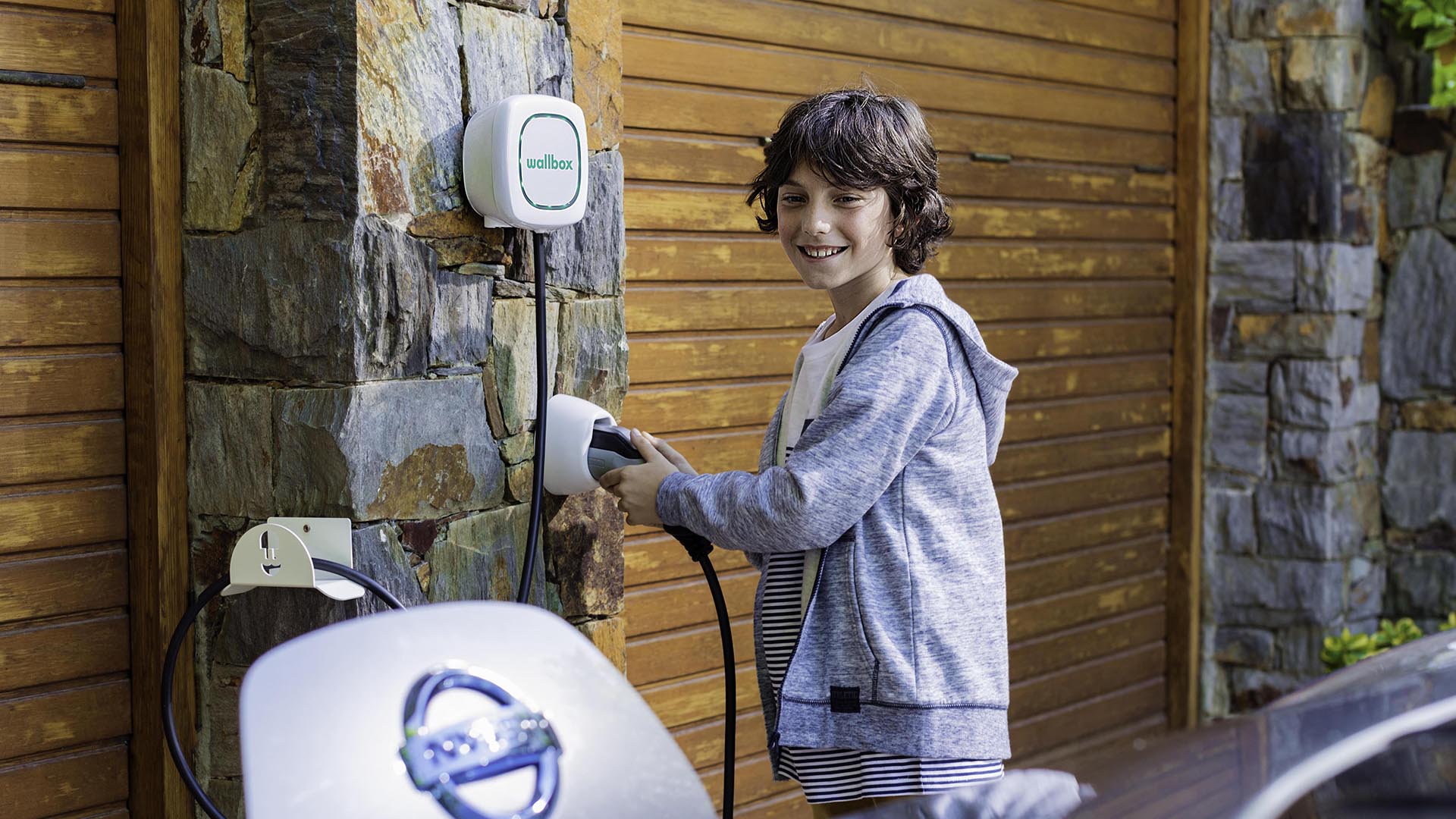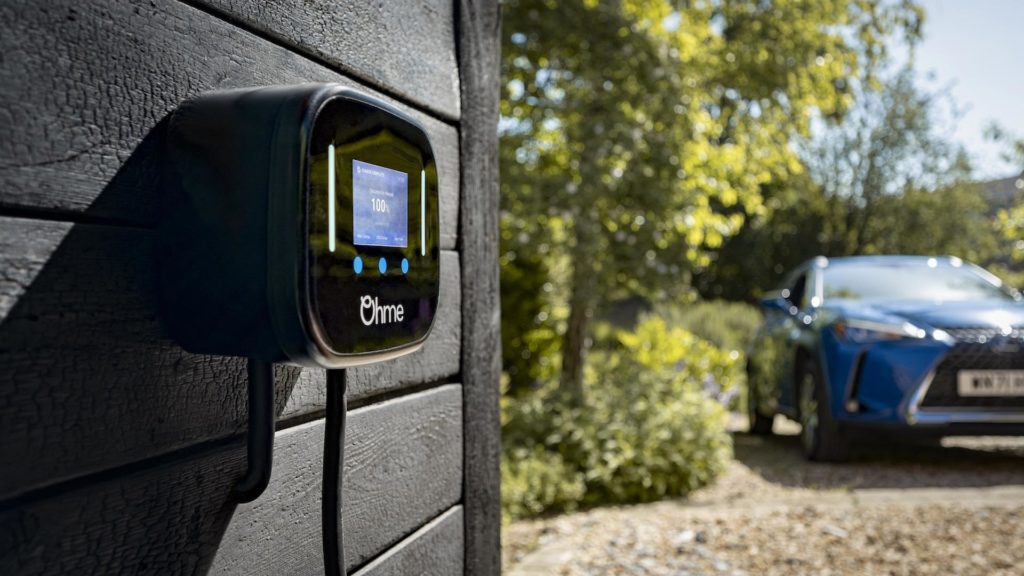Every electric car comes with a cable – sometimes referred to as a ‘granny cable‘ – that is designed for a domestic plug socket. So the short answer to this question is yes – you can charge your EV using a three-pin plug.
However, this method of charging should be reserved for occasional or emergency use only. It’s fine if you’re staying overnight with friends who don’t have a dedicated EV charger, but you don’t want to rely on it.
We’d recommend keeping the granny cable in your car as a back-up. However, there are several reasons why using a dedicated home wallbox is a much better way to charge your electric car. Let’s run through them.
Charger-to-car communication
A proper EV charging wallbox will communicate directly with the vehicle, which makes it safer than using a three-pin socket. With a smart wallbox that can automatically charge when energy is cheapest, you can also take advantage of lower electricity tariffs. These usually apply late at night, when supply is high and demand is low.
A smart wallbox also allows you to control charging remotely, such as via your smartphone. It’s ideal if you want to ‘fill up’ during the cheaper off-peak periods.

Faster charging times
Using a domestic plug socket is by far the slowest way to charge an electric car. Fitting a wallbox will replenish your car’s battery around three times faster, depending on the vehicle.
With a wallbox, most EVs can easily be recharged from empty to full while you sleep. Using a three-pin plug, even an overnight charge (with a generous lie-in in the morning) won’t be enough to full charge the batteries.
Advice for charging at home
The charity Electrical Safety First has the following advice for charging an EV at home:
- Never use a domestic multi-socket extension lead. If you MUST use an extension lead, make sure it is suitable for outdoor use.
- Never ‘daisy-chain’ extension leads by linking them together. This increases the risk of an electrical fire or an electric shock.
- Always buy a charging cable from a reputable retailer or use the cable supplied by the car manufacturer. If you’ve bought a used electric car and the cable is missing, contact your local dealership for that car brand.
- Regularly check the charging cable for wear and tear.
- Ensure the wiring in your property has been checked. Old wiring may not be able to cope with the demand from charging an electric car

If in doubt, fit a wallbox. A 3kW box – which is equivalent to a domestic socket – will cost between £300 and £500. A 7kW unit will set you back between £500 and £1,000, but will deliver far quicker charging times.
UK residents who live in flats or rented properties can claim back up to 75 percent of the cost of a fitted home charge point – up to a maximum of £350. However, you must own an electric car on the approved list and have an off-street parking space. And if you have a house or a mortgage, you can’t apply.
If your property doesn’t have off-street parking, it may be time to ask the local council to install some charging points. Your local authority can apply for help with the cost of fitting on-street points for residential use using the Residential Chargepoint Scheme.
ALSO READ:
Should you buy a plug-in hybrid or an electric car?


How do the interior heaters work? For instance if one is caught in a motorway accident, which may last for several hours, how do you keep warm? Presumably the battery will not keep the vehicle interior temperature at around 20 degrees for several hours. Many cars will run out of battery charge and leave the occupants in peril of hypothermia?
I have seen the preconditioning comment below which will not help in the situation above.
We have a piece coming out soon on this, Alan. EVs use heat pumps for climate control, which these days are far more efficient than first-gen vehicles. A rule of thumb today is 4kW of heat for 1kW battery consumption.
Our explainer will be published in the next week or so – but in short, you should be safe, even if the traffic jam is a couple of hours.
Living in the wilds of N Norfolk a electric car would be virtually impossible to own since there are virtually no public charging points. The management company for my apartment has had an estimate for fitting a charging point for 10 chargers – £121,000!! Why can’t the Government accept that a self charging hybrid is a reasonable alternative. I own a new Yaris hybrid which according to the Toyota is running as an EV for 65-69% of the time in town driving and returning over 70 mpg. If all cars were self charging hybrids we would move very well to lower total urban emissions .
What are the specs your management company asked for these chargers? Or maybe the contractor tried to screw people over, since the tech is still pretty new and people don’t know what it should cost.
The article states “A proper EV charging wallbox will communicate directly with the car, which makes it safer than using a three-pin socket.”.
Please watch this brilliant video on wall boxes: https://www.youtube.com/watch?v=RMxB7zA-e4Y . The short answer is that a wallbox does this communication in order to charge FASTER in a safe way. The slowest way, which the car uses in case no wallbox is present, is always safe. Presuming your home wiring is not defective, that is. In the latter case, just installing a wallbox on the existing wires is just as dangerous as using the granny cable.
EV`S SOUND GOOD BUT WHAT ABOUT THE HEATING OF THE CAR DURING WINTER, AND HOW IS THE WINDSCREEN DEMISTED, SURELY YHIS MUST DRAIN THE BATTERY FASTER?
I have just demisted heated and de-iced my frozen car over a 15 minute period while sitting indoors drinking coffee. My car was fully charged to 207 mile range and at the end of the heating etc used 9 miles of range. This was done remotely via my mobile from the comfort of my armchair. My other petrol car parked in the next bay is still covered in ice. First time I have used this facility but won’t be the last !
[…] charging bays unless you have the capacity – and the intention – to charge your car. EV owners need that plug more than you […]
[…] a dedicated wallbox for charging is faster than a domestic three-pin plug socket. It also allows Mini owners to access the Pod Point smartphone […]
While you can use a domestic socket to charge your EV, in the UK you shouldn’t unless its been installed or verified with that in mind by a fully qualified and competent electrician. It contravenes the IET wiring Regulations to do otherwise which might void your home insurance should the worst occurs e.g. your house burns down. Watch the video entitled ‘Can You Charge an Electric Vehicle From a 13A Socket?’ by eFIXX on YouTube for a full explanation. The direct link to that video is https://www.youtube.com/watch?v=n-F02_fXd8c It’s not hard to comply so why risk it.
lbzuus
iste ratione eos non eos qui vel reprehenderit quia rerum ut aut. error et quia illo dolor doloremque et dolore. deserunt quo natus repellat deleniti voluptas aut iusto. sit voluptatem neque aperiam v